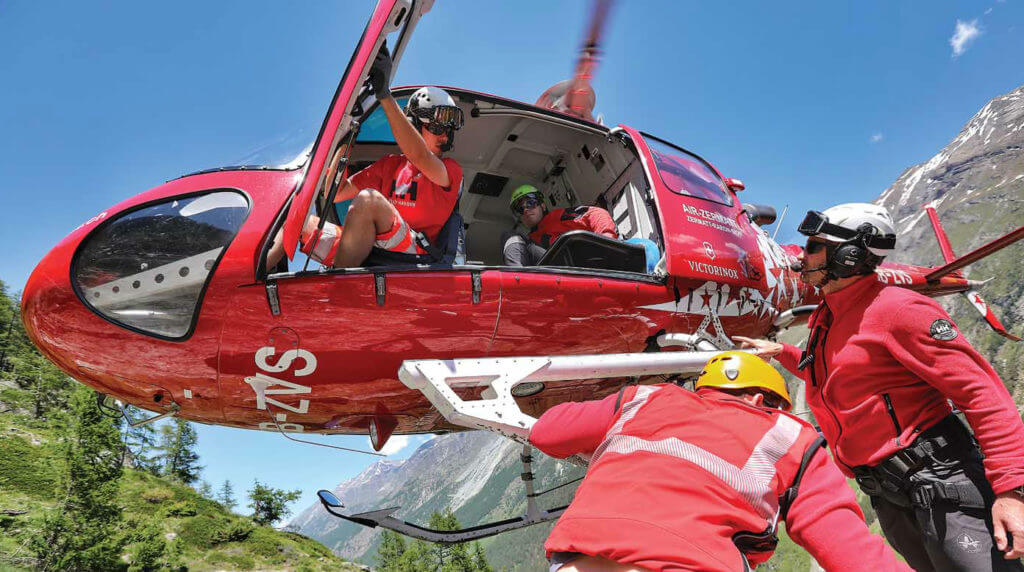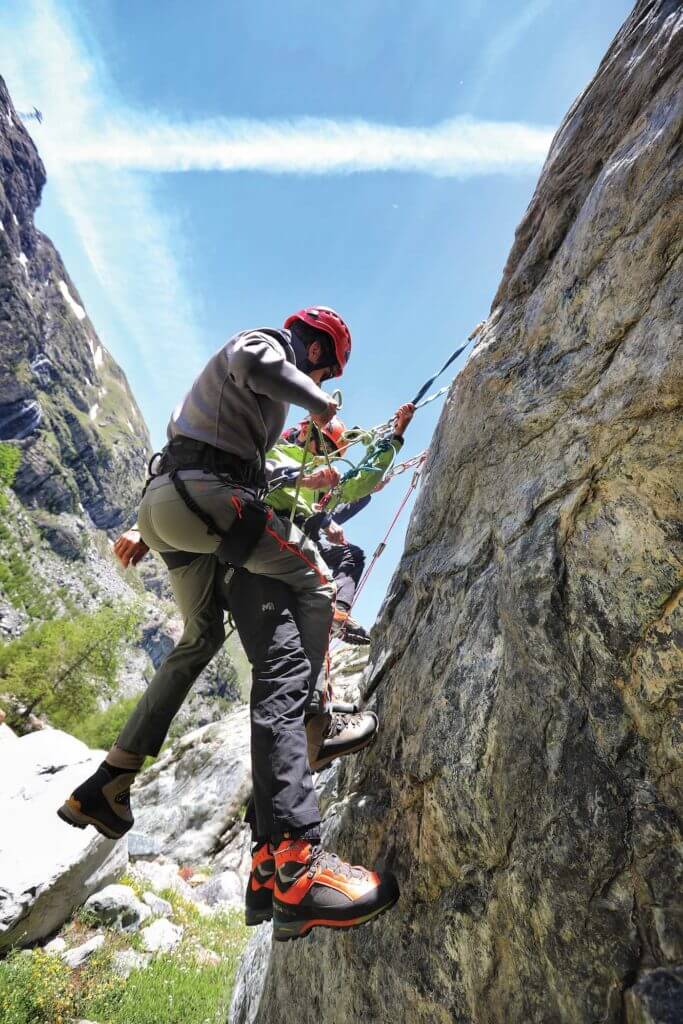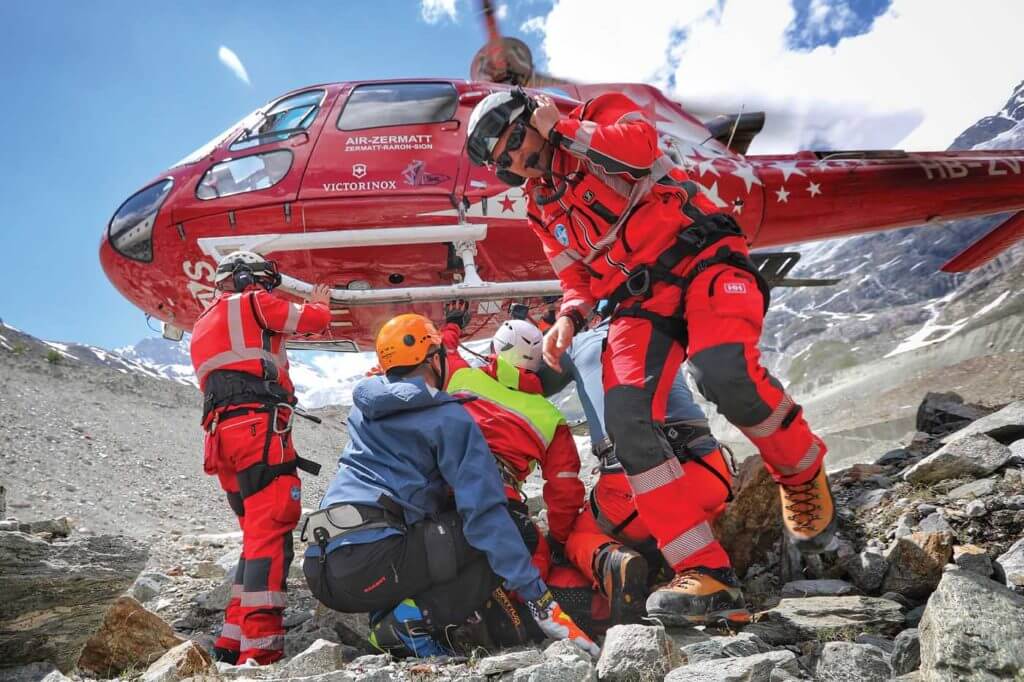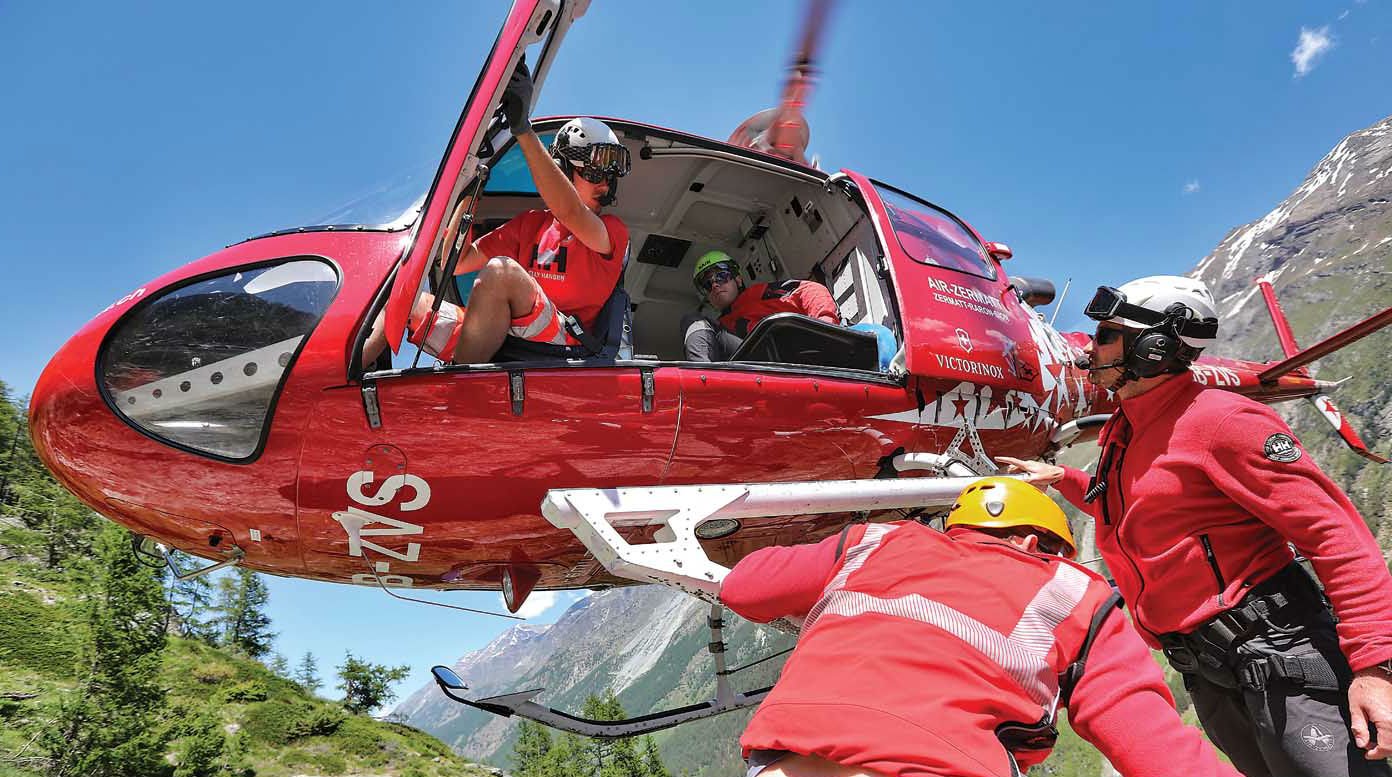The steep train ride to the car-free mountain village of Zermatt, high in the Swiss Alps, is perhaps the first indication that the air medical mountain training course provided by Air Zermatt is going to be very much the real deal. Celebrating its 50th anniversary this year, Air Zermatt has become renowned for its alpine rescues, pioneering new techniques in some of the most challenging conditions in the world. The award-winning business is led by iconic pilot Gerald Biner. With a fleet of nine aircraft, it has bases in Zermatt and Raron, and in 2011 it helped establish a rescue station in the Himalayas.
Alpine HEMS training with Air Zermatt from MHM Media on Vimeo.
Through the Air Zermatt Training Center, it shares the knowledge and skills it has developed over its decades of rescues in the high mountains over various training courses. Earlier this year, I took part in one such program — the company’s Alpine Helicopter Emergency Medical Service and Alpine Flight Crew Emergency Survival (AHEMS-AFCEST) course.
There are usually two course dates, in late spring and early fall. I opted for the June course. The six-day program is designed for groups of six to nine people, and is led by two paramedic instructors, Oliver Kreuzer and Patrick Wenger. Both are very experienced Air Zermatt crewmembers with strong international backgrounds and excellent teaching skills.
After a warm welcome, the necessary housekeeping and a base introduction, we hit the topic of helicopter air rescue in a comprehensive way. “Today is the key day of the whole training,” said Kreuzer. “We’ll cover pretty much everything that is being done in helicopter emergency medical services [HEMS].”

Initial theory boxes guide students through the essentials of helicopter rescue and duties in the HEMS role, regardless of medical background or skill. My group had a good mix of experience and a range of perspectives, including doctors, a mountain guide seasonally flying air rescue in the Himalayas, and some paramedics — all eager to learn or refresh their basic knowledge of high alpine helicopter rescue skills.
Focusing mainly on technical aspects and processes, the initial session saw Kreuzer give a visual explanation of the key rescue techniques used in HEMS. This was followed by a group lunch, and then, in the early afternoon, practical skills training — approaching, and getting in and out of the helicopter while it is hovering.
“As simple as it may seem, this is definitely the most intricate moment of interaction with the helicopter,” said Kreuzer in excellent English. “Both the machine and the rescuer are most vulnerable just in the moment of transferring the body weight from and into the helicopter cabin. There [are] so many factors to take in account, yet the rescuer is not attached either to the helicopter, or to the terrain at the very moment of getting in or out.”

Those who would be expecting lots of theory and light simulation in mild terrain would be terribly mistaken. The students were flown to the steep rocky slopes of Mettelhorn in an Airbus AS350 B3, forming two groups. After the instructors got out, we started practicing the proper technique of getting out and in. There was no illusion — you were simply there in the middle of the action, with the accompanying noise, cold mountain air, steep terrain and downwash. As the session progressed, the terrain became steeper and the helicopter stopped touching the terrain with its skid tips.
Going higher and higher, angled snow fields suddenly replaced grass slopes, adding another element of difficulty. Individual tips and tricks from the instructors, enhanced by experience gained through practicing on the spot, helped hone the technique. Air Zermatt conducts the courses under all weather conditions — as long as its helicopters can fly. After landing back at the heliport there was a group roundtable debriefing, and an overview of the days to come.
Practicing with the longline
The following days were no less interesting, exciting or valuable in terms of gaining experience. The theory classes covered topics such as crew resource management training, weather, navigation, communication, mountain rescue techniques, moving from an air to a terrestrial rescue, and crevasse rescues on a glacier. Practical exercises in the hangar were planned before each in-flight training session.


Proper patient management and longline flying was a day-long project, run through a series of scenarios in a valley under a massive glacier. With time a stressing factor, patient care and proper rescue equipment usage were the main skills to master. Two people joined the group to simulate patients during the exercise. Everybody practiced clipping in and out of the longline, and performed marshalling signals until it became a fluent routine, and received individual debriefing.
Real-life scenarios marked the afternoon program. Mine was a call for a girl who had fallen from a hiking path, breaking both arms and severely injuring her back. Even though I am a flight paramedic, I was assigned the role of a doctor, and had to conduct the patient treatment and rescue while my two crewmates (doctors in real life) acted as paramedics.
There was no “we would do” in terms of treatment — we acted as though the injuries were real. We repositioned and loaded the patient into a Tyromont rescue bag using all the instruments and medicaments from the rescue backpack — no demos, no pretending. The time was counting down, the patient was in pain, the weather was getting worse.

As well as manage the casualty, I had to let the pilot know about the pickup time, and manage the airlift and further routing of the patient. Many very obvious steps became a bit awkward in changing the roles, making the experience even more essential. The cargo hook came to my hand, I clipped in with the patient and an Air Zermatt supervisor, and we lifted off.
Another comprehensive block of theory, given by Air Zermatt’s head of pilot training, covered aerodynamics, the physics of helicopter flight, and aircraft performance, payload and navigation. Even for participants who were learning this information from scratch, it came in digestible portions that built a full mosaic of what a HEMS crewmember should know before a mountain rescue mission. A full morning in the hangar was dedicated to common helicopter systems, especially radios, refuelling, and the principles of hoist operations. Hands-on navigation software practice was led by the pilots.
Performing a vertical wall rescue
The fourth day was the highlight of the course. A longline rescue of a climber from a vertical wall is one of the most difficult tasks a mountain rescuer can perform, requiring skill and good knowledge of rope technique. The weather for our training session looked promising, and we were joined by Thomas Grichting and the legendary Bruno Jelk, two Air Zermatt mountain rescue specialists and mountain guides.

All the participants received a piece of rope, and using two carabiners we started preparing a simple load transfer system tool to safely extract a casualty from a vertical wall. Two maintenance cranes in the hangar served as helicopter longlines, and everybody rotated through the roles of rescuer and casualty.
Shortly before lunch, we moved to some rocks right above the heliport, and came as close to the real-life scenario as possible — in steep terrain, but not too high above the ground. The load transfer system was a simple tool made of a piece of rope and two carabiners, allowing for the fluid transition of weight from the rock to the longline through a Munter hitch, secured with another knot. Cutting the patient off the rope in the rock is certainly a widespread and secure technique, but the load transfer system is the most comprehensive and suitable exercise to release the casualty from a vertical wall in order fly them to a secure location.
After a briefing with our pilot, we were offloaded in two batches under the Gronergrat ridge, and our mountain guides were flown to their vertical wall locations to prepare them for the exercise. A longline was attached under the AStar, and then we each took a turn to fly on the fixed rope to free our friend from the rocks. Even though everything happened under the close supervision of the mountain guides, the panorama, altitude, and solitude on the rope made for a very real atmosphere. There was excitement and a reasonable amount of adrenaline among the students after an exercise done well — but this would be cooled down in what we thought would be the “easy” last day of the course.

The next day of a week spent speaking, living, and even dreaming of helicopters, we were at the base for a later start. With survival kits ready, we boarded the AS350 B3 for survival training in the mountains. Despite the beautiful weather down in the valley, a waterproof down jacket proved vital when we arrived at our destination a couple of hours later. The helicopter left us on a mountain plateau and we discovered it wasn’t coming back — at least not that day.
Patrick Wenger conducted the survival training, with no prior theory class. As the sun set and a warm 70 F (20 C) fell rapidly towards zero, we would have to learn by experience — and quickly. Building an emergency shelter required improvisation. We estimated the best location and while we attempted to start a fire, one of our teammates let out a wild scream as he accidentally cut his leg with a knife while getting wood ready. Although only well simulated, the moment of surprise combined with the difficulty of the conditions made it feel like a real call for action. Many interesting problem-solving scenarios made our night of training in the mountains extremely intense, from sleeping in blizzard bags in freezing temperatures, to preparing food and managing water supplies.
The final day of the course was a question-and-answer day, made particularly challenging with having spent the previous evening under the stars in survival training. Using Air Zermatt’s rescue Bell 429, we saw the hardware and procedures the operator uses on a daily basis — not only for technical rescues and its primary
mission, but also for secondary missions and transport flights.

The students were given their certificates, and we said a final farewell to each other. I then used the generous opportunity of Biner to spend the rest of the day with the crew of the rescue aircraft on duty, observing a glacier rescue of a patient with an injured leg.
Spending a week under Swiss Matterhorn with Air Zermatt helicopters is a once-in-a-lifetime experience. It won’t turn someone into an experienced mountain air rescuer in six days, but it will provide them with the absolute essentials of knowledge and skills needed to provide HEMS in the most challenging of environments.






Are there other HEMS courses planned with Air Zermatt?
Love the rescues.. I’m also a paramedic working on Hems helicopter Department of Health Emergency Medical Services in conjunction with Air Mercy Service.. In Kwa Zulu Natal in Durban.. South Africa… Unfortunately nothing much happens here… I assisted with SA AIRFORCE and Mountain Club of SA…. Enjoy what I do.. Not much Adrenaline… How do get involved in your operation or something similar….